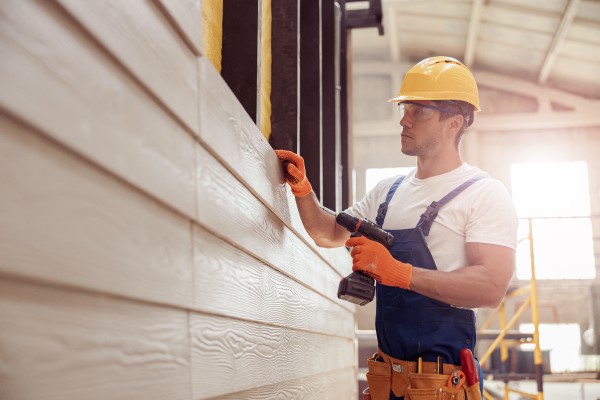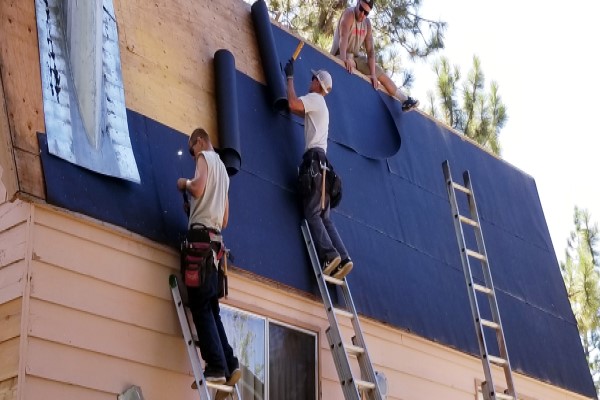


Siding Maintenance Tips: How to Keep Your Home Safe During Storm Season
24 Hour Service • Financing Options • GAF Certified
Quick Estimate Request
Siding Maintenance Tips: How to Keep Your Home Safe During Storm Season
Published 10/8/2024
When it comes to protecting your home from the elements, siding is just as critical as your roof. A well-maintained siding acts as a shield, safeguarding your home from wind, rain, hail, and debris during storm season. However, if your siding is damaged, worn, or improperly maintained, it can leave your home vulnerable to water infiltration, structural issues, and even mold.
Regular siding maintenance, especially before and after storm season, is essential to keep your home in top shape and prevent costly repairs down the line. In this comprehensive guide, we’ll explore practical tips for maintaining your siding, how to inspect it for damage, and what steps to take to ensure it remains protective and intact throughout the storm season.
Why Siding Maintenance is Crucial Before and After Storm Season
Storms bring a variety of challenges for homeowners. High winds, driving rain, hail, and flying debris can all take a toll on your home’s exterior. Your siding is the first line of defense against these harsh conditions, and even small issues can escalate into major problems if left unaddressed.
By maintaining your siding before storm season, you can ensure that your home is well-protected and minimize the risk of damage. After the storm passes, inspecting your siding for any signs of damage allows you to catch issues early and make necessary repairs before they worsen.
Neglecting siding maintenance can lead to costly repairs or even replacement. Damaged siding allows water to seep into your home, potentially causing rot, mold, and structural damage. Investing time in siding maintenance now can save you significant money and stress in the long run.

Pre-Storm Season Siding Maintenance: What to Do
Before storm season begins, it’s important to ensure that your siding is in good condition and able to withstand severe weather. Here’s how to prepare your siding for the storms ahead:
1. Inspect Your Siding for Damage
The first step in pre-storm season maintenance is a thorough inspection of your siding. Check for any visible damage, such as:
- Cracks or Gaps: Cracked siding or gaps between panels can allow moisture to enter your home, which can lead to rot, mold, or even pest infestations.
- Loose Panels: High winds can easily rip off loose siding panels, leaving your home vulnerable. Check for panels that are sagging, pulling away from the house, or appear misaligned.
- Warping or Buckling: Warped or buckled siding is a sign of water damage or improper installation, and these areas are particularly vulnerable during storms.
- Faded or Peeling Paint: While fading may not seem like a structural issue, peeling paint can expose your siding to the elements, reducing its effectiveness in protecting your home.
If you notice any of these issues, address them immediately. Minor problems, such as small cracks or gaps, can be repaired relatively easily. However, more significant issues, like extensive warping or large cracks, may require professional intervention.
2. Clean Your Siding
Over time, dirt, mildew, algae, and debris can accumulate on your siding, not only affecting its appearance but also compromising its durability. A good cleaning before storm season can help prevent further deterioration. Here’s how to properly clean your siding:
- Vinyl and Metal Siding: Use a mixture of water and mild detergent to scrub away dirt and grime. You can also use a power washer, but be sure to use it on a low setting to avoid damaging the panels.
- Wood Siding: Wood siding requires more gentle cleaning. Use a soft brush and a mild cleaning solution to remove dirt, being careful not to soak the wood too much, as this can lead to water damage.
Be sure to clean your siding on a dry day, and allow it to fully dry before proceeding with any additional maintenance tasks, such as painting or sealing.
3. Repaint or Re-Seal Your Siding
If your siding is made of wood, it’s essential to keep it well-sealed or painted to prevent moisture from seeping in. Even small areas of peeling or faded paint can leave the underlying wood vulnerable to water damage. Consider repainting or resealing your wood siding before storm season to ensure maximum protection.
For other types of siding, such as vinyl or fiber cement, a fresh coat of paint isn’t usually necessary unless you want to refresh the appearance. However, it’s important to check for any areas where the siding’s protective coating may have worn off and address those areas accordingly.
4. Check Caulking and Seals Around Windows and Doors
The areas around windows, doors, and other openings are particularly susceptible to leaks and water damage during storms. Check the caulking and seals around these areas to ensure they’re intact and free of gaps. If the caulk is cracked, brittle, or missing, replace it with high-quality exterior caulk to prevent water from seeping behind your siding.
5. Trim Nearby Trees and Shrubs
Storms can turn nearby trees and shrubs into hazards. Overhanging branches or large shrubs close to your home can cause damage to your siding during high winds or heavy rain. Trim back any branches or vegetation that could potentially scratch or dent your siding during a storm.
When to Call a Professional
While minor maintenance tasks like cleaning and re-caulking can often be done by homeowners, some siding issues require professional attention. If you notice any of the following, it’s best to call a siding contractor:
- Extensive Cracking or Warping: Large cracks, widespread warping, or significant water damage likely indicate a deeper issue that requires professional repair or replacement.
- Major Storm Damage: If a storm has caused significant damage to your siding, such as large sections missing or dented panels, it’s important to get a professional assessment. A contractor can determine whether repairs are sufficient or if replacement is necessary.
- Unseen Water Damage: If you suspect water has infiltrated behind your siding but can’t see any obvious signs, a professional can use specialized tools to detect moisture and prevent further damage.

Post-Storm Siding Inspection: What to Look For
After a storm has passed, it’s essential to inspect your siding for any signs of damage. Here’s a checklist of what to look for:
1. Check for Physical Damage
The most obvious signs of storm damage are physical impacts to your siding. Look for:
- Dents and Dings: Hailstorms, in particular, can leave small dents and dings in your siding. While this may seem like a cosmetic issue, dents can weaken the siding over time and make it more susceptible to future damage.
- Cracks and Holes: Flying debris during storms can cause cracks or holes in your siding. Even small holes can allow moisture to seep in, leading to bigger problems like rot or mold.
- Missing or Loose Panels: Strong winds can dislodge or completely remove siding panels, leaving your home exposed. Inspect your siding for any missing or loose pieces that need to be replaced or re-secured.
2. Look for Signs of Water Damage
Water damage is a major concern after heavy rain or storms. Even if your siding appears intact, water may have infiltrated behind the panels. Check for:
- Stains or Discoloration: Water stains or discoloration on your siding can indicate that moisture has seeped in. Look for areas where the color appears darker or streaked, particularly near the roofline or around windows and doors.
- Swelling or Warping: Water damage can cause siding to swell, warp, or bulge. If your siding feels soft or spongy to the touch, it’s a sign that water has gotten in and is affecting the material.
- Mold or Mildew: Mold and mildew growth on your siding, especially in shaded or damp areas, can indicate that moisture is trapped behind the panels. Address any mold or mildew growth promptly to prevent it from spreading.
3. Inspect Seals and Caulking
As mentioned earlier, the areas around windows and doors are particularly vulnerable to water damage. After a storm, recheck the seals and caulking around these areas. If any of the caulking has been damaged or washed away by the storm, reapply it as soon as possible to prevent water from entering your home.
4. Clean Off Any Debris
Storms often leave behind debris, such as branches, leaves, and dirt, that can accumulate on or around your siding. While this debris may not cause immediate damage, it can trap moisture against your home, leading to long-term issues. After a storm, take the time to clear away any debris and give your siding a gentle cleaning if necessary.
Stay Proactive to Protect Your Home
Siding maintenance before and after storm season is essential for keeping your home safe and intact. By regularly inspecting, cleaning, and repairing your siding, you can ensure that it remains protective against the elements, reducing the risk of costly repairs in the future.
Remember, the key to protecting your siding is being proactive. Don’t wait until after a storm has caused damage to inspect your siding—regular maintenance and pre-storm preparation can help minimize the impact of severe weather. And after a storm passes, a thorough inspection will help you catch any damage early, allowing you to address it before it becomes a bigger problem.
With these siding maintenance tips in mind, you can keep your home safe, secure, and protected during storm season and beyond.
In-House Staff
Our employees are in-house.
You Deserve the Best
Check out our reviews!
Customers First!
Customer-focused solutions.
Xterior PRO Roofing & Siding, LLC
Financing Available
24/7 Emergency Availability
Certified by GAF & Owens Corning
We Work With your Insurance!
Areas Serviced
- HQ: Newburgh, NY
- Beacon, NY
- Cornwall, NY
- Fishkill, NY
- Middletown, NY
- Monroe, NY
- New Paltz, NY
- New Windsor, NY
- Poughkeepsie, NY
- Wallkill, NY
- Wappingers Falls, NY
- Warwick, NY





